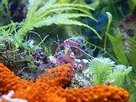Cleaner Shrimp - Lysmata amboinensis - Cleaner Red Skunk Shrimp - White-Striped Cleaner Shrimp

Taxonomy: Cleaner Shrimp belongs to the Kingdom Animalia, Phylum Arthropoda, Class Crustacea, Order Decapoda, Family Hippolytidae, Genus Lysmata and Species amboinensis.
Scientific names: The scientific name of Cleaner Shrimp is Lysmata amboinensis
Other common names: Cleaner Shrimp is also known as Scarlet Skunk Cleaner Shrimp and Cleaner Red Skunk Shrimp.
Origin or natural range: Lysmata amboinensis is found in the tropical Indo-Pacific region and the Red Sea.
Size: Cleaner Shrimp may grow up to a size of around two inches.
Color: Lysmata amboinensis occurs in red, golden and white colors.
Compatibility: Cleaner Shrimp is non-aggressive towards the other marine aquarium members.
Habit & Habitat:
- Lysmata amboinensis shares a symbiotic relationship with fish. Cleaner Shrimp gets food from the body of fish in the exchange of fish body being cleaned all the while the shrimp is eating things off.
- Lysmata amboinensis cleans the fish body both externally and internally off any parasite, generally Ich, or any other unnecessary material present on them. To have themselves cleaned naturally by the Cleaner Shrimp, fish settle upon a coral head or in a space between two coral growths, called cleaning station. The fish then face an unusual direction and open their mouths wide to hint to Lysmata amboinensis that it will not be eaten by the fish. After getting the signal, Cleaner Shrimp begins to eat parasites and the other waste present on the body of fish. After externally cleaning the fish, Lysmata amboinensis goes into the oral cavity of fish to reach up to their gills and clean them and then comes out uneaten. Because of its cleaning temperament, Cleaner Shrimp got the name.
- Lysmata amboinensis molts per three weeks to four weeks.
- Temperature of water: Seventy-two to seventy-eight degrees Fahrenheit or twenty-two to twenty-six degrees Celsius.
- Specific gravity of water: 1.023 to 1.025.
- pH of water: 8.10 to 8.40.
- Illumination: Cleaner Shrimp requires low light in the marine aquarium it inhabits.
- Habit & habitat:
- To host Lysmata amboinensis, you should have a reef type marine aquarium.
- You can keep Cleaner Shrimp in a small group of two to three.
- Feeding & Nutrition:
- Lysmata amboinensis is Omnivorous in its feeding habit and feeds many times per day according to its age and size.
- Cleaner Shrimp generally eats parasites present on fish, the meaty bits of seafood, veggie flakes, pellets and Scavenges on dead tissues, called detritus.
- Breeding:
- If more than one Lysmata amboinensis is present in your marine aquarium then, they will breed.
- Upon spawning, you will observe light green colored eggs in the finlets situated below the carapace of Cleaner Shrimp.
- The larvae of Lysmata amboinensis, however, hardly survive in a captive environment and are also eaten by fish and corals in your marine aquarium.
- Benefits: Cleaner Shrimp helps clean the fish off any parasites present on them externally as well as internally. If medication is used to treat fish then, the chemicals may harm corals in the marine aquarium. Lysmata amboinensis, however, is the safest and the most effective method of controlling the parasites ailing the fish in your reef tank.
- Cleaner Shrimp is easy to maintain owing to its non-poisonous nature.
- Fluctuations in the water quality, especially changes in the specific gravity of saltwater, may adversely impact the health of Lysmata amboinensis.
- Add Iodine to the water as dietary supplement for Cleaner Shrimp to smoothen up its molting process.
- High levels of Copper and Nitrates in the marine aquarium may prove lethal for Lysmata amboinensis.
- An aged Cleaner Shrimp becomes quite lethargic and is unable to frequently perform the cleaning process or even eat on its own. Therefore, you will need to feed it directly from your hands.
- Some fish such as, Hawk Fish, Trigger Fish, Squirrels, Lionfish and Groupers, etc, may eat Lysmata amboinensis. Therefore, do not keep these fish and Cleaner Shrimp in the same tank.
- Cleaner Shrimp may bite into the food that is being fed directly to the Long Polyp Stony (LPS) Corals, fish or any other marine aquarium member.
- Lysmata amboinensis may also disturb the corals causing them to close down temporarily.

Fire Shrimp - Lysmata debelius - Scarlet Cleaner Shrimp - Blood Shrimp - Fire Shrimp
Freshmarine: $43.98
You Save 37.16%
Glass Anemone Shrimp - Periclimenes brevicarpalis - Pacific Clown Anemone Shrimp
Freshmarine: $19.95
You Save 31.18%
Before Placing Your Order
Store InformationShipping Info
Payment Info
Return Policy
Arrive Alive Guarantee
Adoptation Policy
After Placing Your Order
Track Your OrderSecurity Safe Shopping
Compatibility Chart
Shoppers Review










